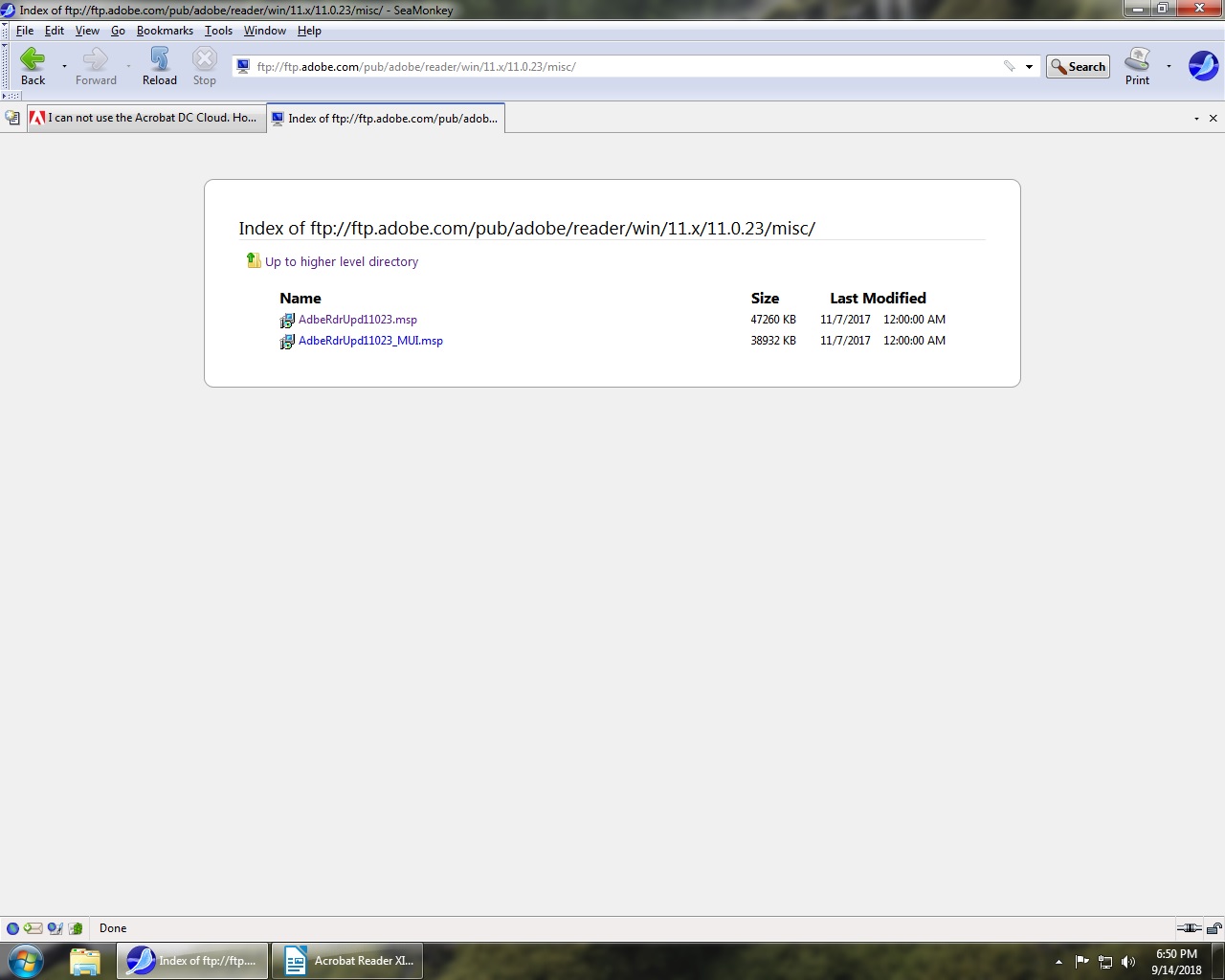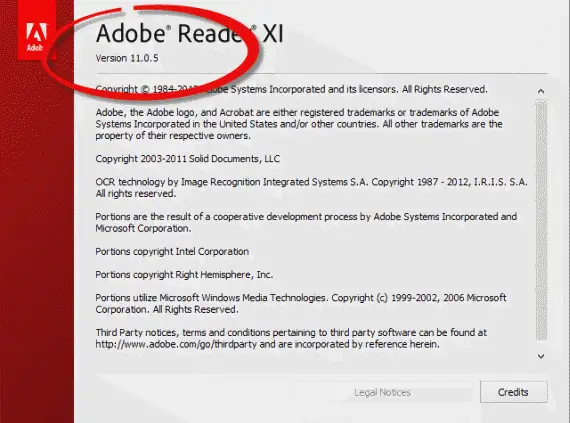- Ftp Ftp Adobe Com Pub Adobe Reader Windows 10
- Ftp Ftp Adobe Com Pub Adobe Reader Win 10
- Ftps //ftp.adobe.com/pub/adobe/reader/win/acrobat Dc/
Jan 15, 2014 Solved: When I downloaded the 1/14/2014 release from the FTP site and installed the version was 11.0.0 and wanted to update to 11.6, does anyone know where I - 5771366. Feb 13, 2011 A search on this forum for 'FTP' shows many, many requests for the ability to download Flash Player via FTP. That same search shows exactly NO answers for why this is not available. And PLEASE do not use this message as justification for removing Adobe Reader from ftp.adobe.com.
Continuous or Classic track?¶
The Acrobat product family provides two tracks for both Acrobat and Reader:
The Continuous track provides service-based tools as well as new features, security and platform enhancements, and bug fixes as part of frequent (and most often) silent updates. Over time, the Continuous track’s update cadence will be more frequent than the Classic track. Classic license program customers do not have access to this track for Acrobat.
The Classic track is similar to the 11.x model and provides few (if any) new features in updates. Free services are available, but optional. Like previous releases, a quarterly update cadence delivers security and platform enhancements as well as bug fixes.
Note
For up-to-date details about what features exist in each track, see https://helpx.adobe.com/acrobat/using/whats-new.html.
Ftp Ftp Adobe Com Pub Adobe Reader Windows 10
Example release schedules:
Which track should I use?¶
Continuous track¶
Choose this track if you:
Use named-user deployments; that is, you want to manage entitlements through enterprise IDs. In service-centric environments, it’s beneficial to have a single identity of the user across the desktop, mobile & cloud. DC products support federated and enterprise IDs for identity-based licensing.
Want new features delivered in updates as soon as they become available.
Use DC web services.
Would like to take advantage of frequent updates for security and functionality reasons (you can leverage the silent and automatic update mode, but it is not required).
Can automatically update or push controlled updates on a 60 day schedule. Since web and desktop updates are released in tandem, keeping the desktop updated ensures features and functionality remain synchronized with Document Cloud services.
For the Continuous track, only the latest base release and last update will be available for download.
Classic track¶
Choose this track if you:

Use serialized deployments; that is, you don’t need identity-based licensing and deployment and the ability to manage users via the Admin Console.
Want to limit the feature set to those included in major releases.
Have not purchased services.
Want to manage updates like previous 11.x releases.
Manage a locked environment and need to control the frequency and nature of updates. All updates remain available for download.
License types¶
Licenses are associated with a particular track. A Continuous track license cannot be used with a Classic installer and vice versa.
License programs¶
License program | Plan names | Tracks |
|---|---|---|
ETLA | Adobe Document Cloud for enterprise: Premium 1, Premium 2, Pro w/ services, Std w/ services | Continuous |
ETLA | Adobe Document Cloud for enterprise: Pro or Std | Continuous |
ELA, CLP, TLP | Adobe Acrobat Pro Document Cloud and Standard Document Cloud | Classic |
VIP | Adobe Acrobat Pro Document Cloud and Standard Document Cloud | Continuous |
Can I switch tracks?¶
With the right license, yes. Installing a different track requires uninstalling the existing product first.
Acrobat Professional vs. Standard¶
Acrobat Professional and Standard DC are delivered as a single installer. Product behavior and features become enabled based on the entitlements granted by the licensing methodology (a user ID or serial number).
Licensing (provisioning)¶
DC products support named users deployments in addition to traditional, serialized deployments. Named user deployments provide the following advantages:
Management of usage rights for users and groups via the Admin Console.
Streamlined license management and compliance.
Provisioning mobile devices for Document Cloud services.
Leveraging existing systems so that users can fully participate in more efficient e-sign workflows.
Item | Named user deployment | Serialized deployment |
|---|---|---|
License access | Licensing website (LWS) | |
License association | Assigned users and groups | Specific machines |
License programs | ETLA, VIP | ELA, CLP, TLP |
Entitlement granted to | each user | each machine |
Entitlement management | Admin Console | Pre-deployment configuration |
Internet connection | Required: Users must log in and signing out deactivates product. | Only required pre-deployment for activation |
Activation | Occurs on user log-in | Admin pre-activates for all users |
Services ID | Adobe ID | |
Integrated mobile provisioning | Yes | No |
Services access | Yes (optional) | Yes (optional) |
Virtualization support | App-V (Jan 2017: Citrix, VMWare) (Nov 2017: WTS) | Citrix, WTS, App-V |
SCCM, AIP/GPO, ARD | Yes | Yes |
Track support | Classic, Continuous | Classic only after Dec. 2018 |
* For the VIP program, the product performs an online activation check every 24 hours. Users can be offline for 30 days on the monthly plan and 99 days on an annual plan.

Installer bit locations¶
The requisite installers are available from the following locations:
Location | Continuous | Classic |
|---|---|---|
What’s available? | Base installer and last update | Base installer and all updates |
Base installer | None | |
Base installer | Base installer | |
Download pages (Acrobat 2017, Acrobat 2020) | Last update only | All updates |
| All updates |
Location | Continuous | Classic |
|---|---|---|
What’s available? | Base installer and last update | Base installer and all updates |
Admin Console | None | None |
Download pages | Base installer and last update | Base installer and all updates |
| All updates | |
get.adobe.com | Latest full installer | None |
Continuous vs. Classic comparison¶

Acrobat product tracks¶
Feature | Continuous | Classic |
|---|---|---|
Updates | Frequent | Planned quarterlies |
Update order | Base + last update | Base + last update |
Update UI | Auto or off | Auto or off |
Update registry controls | Auto or off | Win: Same as 11.x |
Services integration | All tools enabled | Free tools only |
Upsell enabled? | Standard only | N/A |
Languages | MUI only: licenses are language specific | MUI only: licenses are language specific |
File and preference paths | Versionless: always under | Versioned: Under major version, 2015|2017|2020, etc. |
Windows installer |
|
|
Windows install paths |
|
|
Registry paths |
|
|
Application data path |
|
|
FTP download locations |
|
|

* What services are visible in the user interface varies by the purchased track and license type. Use the Customization Wizard or registry/plist configuration to remove unwanted items from the user interface.
For the Continuous track, all services are visible and functional. Note that some features, such as Create PDF and Export PDF, are part of the desktop offering and don’t use a DC service.
For the Classic track, paid for service-based tools are unavailable. Features such as Export PDF are part of the desktop product and don’t require a service to function. Free services which don’t duplicate existing functionality are on by default.
Reader DC tracks¶
Ftp Ftp Adobe Com Pub Adobe Reader Win 10
Feature | Continuous | Classic |
|---|---|---|
Updates | frequent; often silent | Planned quarterlies |
Update order | Base + last update | Base + last update |
Update UI | None (no UI but registry settings can still be used) | Auto or off |
Update registry controls | Auto or off | Auto or off |
Services integration | All tools visible | Free tools visible |
Upsell enabled? | On by default | On by default |
Spelling pack | Add on | Bundled |
Font pack | Add on | Bundled |
Languages | Win: single language or MUI | MUI only |
File and preference paths | Versionless: always under | Versioned: Under major version, 2015|2017|2020, etc. |
Windows installer |
|
|
Windows install paths |
|
|
Registry/plist paths |
|
|
Application data path |
|
|
* What services are visible in the user interface varies by the purchased track and license type. Use the Customization Wizard or registry/plist configuration to remove unwanted items from the user interface.
For the Continuous track, all services are visible. Free services are functional by default, and paid-for services require an upgrade or purchase to access.
For the Classic track, most service-based tools are hidden. Basic, paid-for services such as Create PDF and Export PDF are visible but must be enabled with a purchase.
Product versioning¶
Track release schedules and their respective versions will be different, but both the Continuous and Classic tracks share an identical methodology. The new strategy is designed to provide better granularity, support more frequent releases, and aid in troubleshooting by providing build information. In it’s generic form, the version number will appear as major.minor.minor_minor.
Version | Range | Notes |
|---|---|---|
major | 1-255 | The last two digits of the release year.* |
minor | 1-255 | An internal number indicating when code moves from Trunk to Beta. |
minor_minor | 1-65535 | The first two digits indicate the track. 20 = Continuous. 30 = Classic. |
Hidden 4th field | Changelist number | Only visible if user clicks on the version number in the About box. |

Ftps //ftp.adobe.com/pub/adobe/reader/win/acrobat Dc/
* The year-based version number is not the same as the Classic track name. While the Classic track versioning contains a year-number (2015|2017|2020), the track name only changes at each major release–not every year. The version number increments every year.
